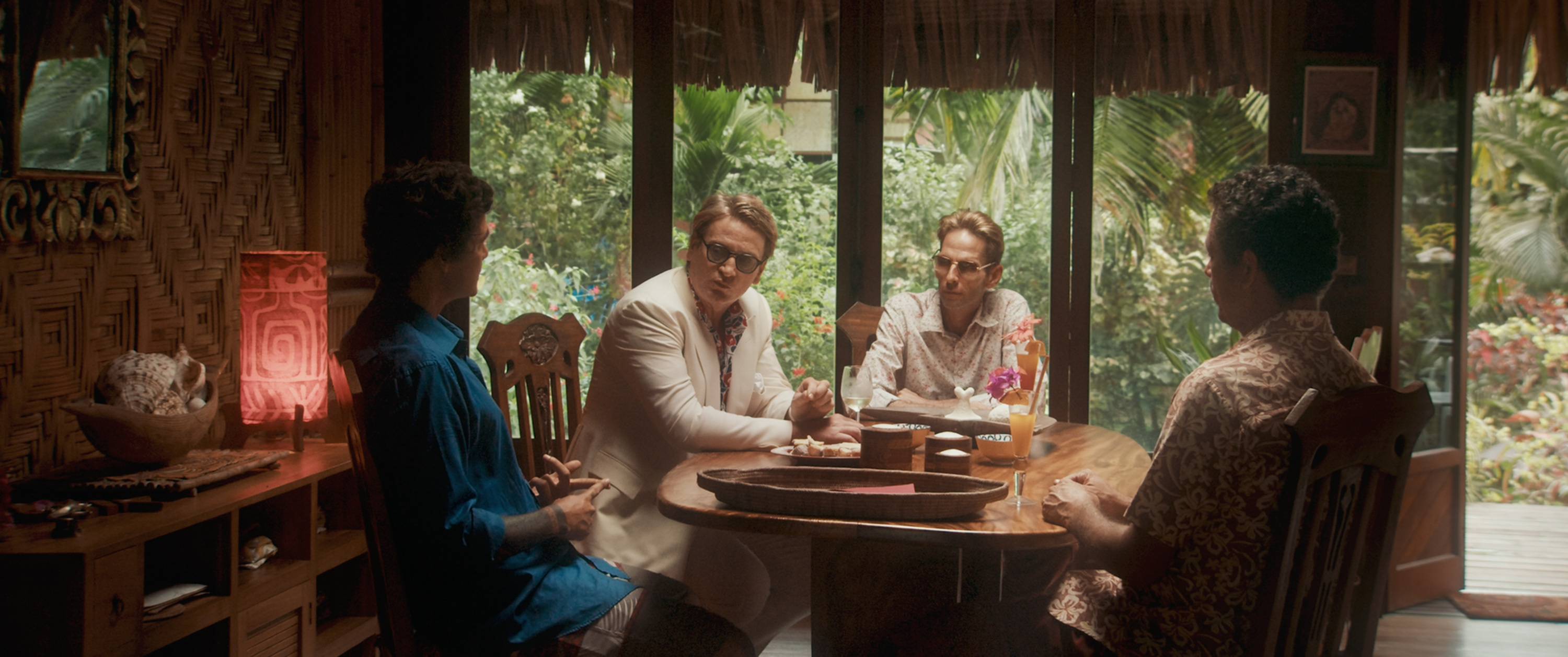To hear Albert Serra tell it, his newest film, Pacifiction, isn’t necessarily about anything, despite its variegated thematic possibilities, encouraged by the contemporaneous setting—a first for this divisive filmmaker. De Roller, the French High Commissioner in Polynesia (played by a career-best Benoît Magimel, channeling multiple Ben Gazzara bullshit-artist performances), investigates the rumors of resumed nuclear testing on the island, a sinuous threat both confirmed and denied in equal measure. Serra’s intensively unorthodox methodology––multiple cameras, lines fed through earpieces, an editing process that excised “all cliches,” oversaturated colors, courting tongue-in-cheek beauty with a 2.39:1 frame––is all in the service of aestheticized ambiguity, which earns its place across Pacifiction’s 180 minutes.
I met with Serra the morning after the film’s NYFF premiere, and the director was eager to parse his film’s various interpretations, belonging both to him and the audience. He was also not opposed to namedropping in earnest, clarifying the film with a combination of admitted influences and on-set stories.
Projektor: Because your guidelines for shooting and editing are so specific, I wanted to know whether you had the idea for the narrative first, or if the material and these methods developed simultaneously?
Albert Serra: I think that there was the idea of doing something more rooted in narrative at first, because this methodology could easily be applied. However, the subject was already not a typical narrative, because it’s obscure, and the characters are mysterious: I don’t even know who is or isn’t a spy, who’s working for who, who’s dedicated to the local population, who isn’t. It is a narrative film, but I’m not obsessing over clarity. I want my touch to be as light as Max Ophüls’, a little thing, a live thing that spreads, that evolves. I never wanted it to require too much drama, instead concerning itself with the movements of the main character. The film is contemporary in the sense that it is not about the world, but our perception of the world, and that’s why we never truly know who’s in command. I don’t have much to say that could define an entire film; I don’t even care that much about the subject. I want observations to arise about the humans present.

As if they were coincidental.
Exactly. And it’s always about performance. The film is not a documentary, it’s very much a fantasy. When people visit Polynesia or elsewhere, they’re able to identify the victims of colonialism, those that’d be affected by the nuclear threats in the film. But that’s not what I’m concerned with, that’s what my little, light touch brings out. There is no reality, there’s not even a street or a restaurant that looks like real life, with people in the background. It’s a mental film, so very few extras, except maybe for the discotheque or the scene out on the water, because we’re living inside De Roller’s mind, his paranoia. Everyone we’ve noticed, he’s noticed.
Because we shot during lockdown, there weren’t even people about to begin with. It’s a spectral vision I had to conjure, something imaginary, like in Vincente Minnelli’s Brigadoon, how the village appears out of nowhere. And this is a huge contrast to the way the actors perform (who were very eager to appear realistic), to the point where you can’t believe what you’re seeing.
I got the impression each conversation was a mutual attempt between characters to try and suss out one another’s true motivations.
It’s like what De Roller says about the writer. He says that there’s no history, he’s always just trying to create a foreign language, with his notebooks and activities, even if that obscures the film. That’s part of its intrigue, you never know how much he’s attached to the population, or if he’s serving the interest of whoever’s above him. I use the vanity of the shoot—the methodology of three cameras—so that Magimel really is performing in this ambiguous realm, without a script, so we created the performance in real time. So there is no trace of true representation. We put him in a super artificial context, with supersaturated colors, pushing it to the level of being fake. For example, the rosiness and orangeness of the sun, which you’ll never find anywhere; it’s like we made a postcard—we put a performance in a generic postcard.
I did this somewhat in my previous films, because of their historical setup which is not connected to our world. But here it was more complex because of the artificiality applied to our world and what we deal with. It becomes more challenging as a filmmaker but also for the spectator, to understand the purpose of these images, especially when mixed with humor.
I don’t have much to say that could define an entire film; I don’t even care that much about the subject. I want observations to arise about the humans present.
Magimel is very funny. Did he take immediately to the earpiece?
Yes, and very strange, too—people are always a little bit shy. When I was watching the film with an audience, I realized it was a shy kind of laughing. You don’t know if you’re “supposed” to openly laugh, and that gives it the kind of enjoyable complexity, like in a Tarantino film.
And Magimel is very open minded, even though he said no at the beginning. He’s had some problems, so he’s both wild and quiet, which worked, because I like to mix methods in every scene, skipping rehearsals, not talking about the script with the actors. I like to cheat them, setting up three cameras, not telling them where to look, where the zoom will be, creating both pressure and noncommunication, so the actors would lose control of their image; the body would react before the rest of them could. They become automatic.
This gave us the freedom to avoid cliches. Magimel really did not care: he had imagination, so then if the earpiece was going too fast, he didn’t let himself get trapped, he came up with something even better. This was my only rule: it will go fast but don’t stop, keep on. He was able to create the scenario for himself right in front of the camera, beyond the corny suit and edgy sunglasses. He doesn’t know what he’ll do in 10 seconds, or two minutes, or 14—it creates a new texture. Magimel was often surprised by the other actors I fed lines to: under all the pressure put upon him, his character becomes a little weak, and that’s also him as an actor. He was upset about not having the tools to deal with certain scenes, and after one particular take he came up to me and said, “Albert, I don’t allow anyone to talk to me like that, not even in fiction.”

Am I correct in detecting something of a New Hollywood influence, both in the performances, and the general sense of paranoia?
The one film from that time that’s actually connected to Pacifiction is The Parallax View. The static visuals, the color oversaturation, that was our thought, and I was thinking about the distortions, the negative space, a physical anticlimax. The tonalities are very ‘70s, but in a modern way. The form was academic, more or less, but something like Apocalypse Now has actors inside the recreation of this crazy world. But I think we were closer to Sirk than we were Coppola, working with the unfairness of images, forcing the viewer to accept the discomfort. The film progresses, and it imposes its own logic on you, and you have no choice but to submit, to accept its influence.
The weather and the elements almost act for the climaxes the narrative doesn’t provide.
Yes, because the idea was that there was some purity, or harmony, between nature and humans that’s being destroyed, this almost innocent relationship. And I’m very shy, very innocent myself, and that’s what I want to keep alive, no matter what.

